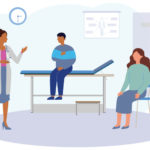Gun violence and children: Why it’s a public health issue

“There have been more than 52,000 pediatric firearm deaths in the past 18 years,” says Dr. Eric Fleegler, a pediatric emergency physician at Boston Children’s Hospital as he kicks off his talk. It’s May 3, 2018, and he’s sharing the startling statistic with a rapt audience at the hospital’s Special Grand Rounds on Trauma and Gun Violence.
Later that same day, a 10-year-old Ohio boy will be shot in the face while he sleeps in bed, one of 11 bullets to enter his home during a drive-by shooting. Three North Dakota siblings ages 6 to 14 will be murdered by their mother — who will then kill herself — with a handgun. The following day, a 3-year-old South Carolina boy will fatally shoot himself in the head while playing with a gun he finds at a family friend’s home.
The boy from Ohio will survive. The others will join the average of seven children and teens who are killed by firearms every day, a grim tide that shows no sign of ebbing. Despite such overwhelming numbers, misconceptions about kids and gun violence abound. Here are five takeaways from the Grand Rounds event for both clinicians and parents.
Most shootings don’t make the news.
As gun violence becomes more pervasive, mass shootings tend to be the incidents that make headlines. But such large-scale brutality may mask a greater concern. “It’s the Parklands and the Sandy Hooks that tug at our heartstrings,” says Dr. Fleegler. “But the statistics for other gun-related deaths are actually much higher than those for mass shootings.”
Of the 1,300 children who die each year from firearm-related injuries, more than half are homicides. Those who are teenagers, black or male are most likely to be victims; these shootings often involve crime, gang activity or being a bystander to such conflicts. “Poverty is a direct vehicle to gun violence,” explains Massachusetts State Representative Chynah Tyler, who serves constituents from Dorchester, Roxbury and other areas in the Seventh Suffolk district. “We need to focus on why kids want to pick up guns in the first place and give them the resources to prevent that from happening.”
Firearms make suicide attempts fatal.
Suicide is the third leading cause of death in Americans ages 10 to 17 — and about half of these kids used a firearm to end their life. “You can’t talk about suicide in the United States without talking about firearms, and you can’t talk about firearms without talking about suicide,” says Dr. Matthew Miller, co-director of the Harvard Injury Control Research Center and another speaker at this Grand Rounds.
His research suggests that having a gun in the home is strongly associated with higher rates of suicide, probably in part because firearms are more lethal than most other suicide methods. Yet suicide is a largely impulsive act, particularly among children and teens, notes Dr. Miller. “When you reach for a gun in a moment of weakness, you don’t get a second chance,” he says. “So if you can prevent someone from killing themself today by restricting their access to guns, you have very likely saved their life in the long term, as well.”
There’s a ripple effect.
On the night after the hospital’s Grand Rounds event, two men are killed in the city’s Jamaica Plain neighborhood, innocent bystanders in a gang-related shooting. Located just yards away from the scene, the clinicians and staff at Martha Eliot at Boston Children’s are all-too familiar with the effects of gun violence, both on themselves and on the families they serve.
The community health center serves on Jamaica Plain’s Neighborhood Trauma Team, part of a citywide network aimed at addressing the aftermath of violence. Tasked with providing support and resources to residents in the wake of violent acts, these Boston Children’s clinicians understand that shootings can have a lasting impact not just on victims and bystanders but also on the community at large.
Indeed, a recent survey by the network found that 74 percent of their new clients reported being chronically exposed to single or multiple forms of violence — experiences that can manifest as toxic stress and worry in the long term, says Catherine Fine, director of the Boston Public Health Commission’s Division of Violence Prevention.

Ownership increases risk.
It’s natural for parents to want to protect their children, which is why many families say they own firearms for self-defense: In the U.S., an estimated 1 out of 3 homes with kids have guns. However, research suggests that these guns are more likely to be involved in unintentional shootings, assaults, or suicides than to be used for self-defense. The majority of guns used in suicide attempts and unintentional shootings of children and teens are stored in the home of the victim, a relative or a friend — and over 1.69 million Americans age 18 and under are living in households with loaded and unlocked firearms.
Legislation makes a difference.
In a landmark 2013 study of the relationship between firearm legislation and firearm-associated fatalities in the U.S., Dr. Fleegler and his colleagues found that states with the most firearm legislation have the lowest rates of firearm-associated deaths overall, as well as the lowest rates of firearm-associated suicides and homicides. The states with the most laws have a mortality rate 42 percent lower than those states with the fewest.
Since then, other studies have come to similar conclusions, with the strongest evidence for laws that strengthen background checks and that require a permit to purchase a firearm. However, it’s still unclear whether other types of laws, specifically those that curb gun trafficking, improve child safety, ban military-style assault weapons and restrict firearms in public places, have an effect on deaths.
It’s a controversial issue to be sure, but one that Dr. Fleegler and his colleagues believe needs to be addressed head on, by parents, clinicians and public policy. “When 20 percent of deaths in young adults are from firearms,” he asks, “how can we possibly say that this isn’t a public health issue?”
Related Posts :
-

Firearm suicides in children and youth: A state-by-state look
At a time when mental health problems are skyrocketing, a new study provides one of the most comprehensive state-by-state accountings ...
-

Powerful new antibody neutralizes all known coronavirus variants
As the COVID-19 pandemic wears on, newer variants of the SARS-CoV-2 coronavirus have been evolving ways to evade the antibodies ...
-

A new symptom of COVID-19 in young children: Croup
During the Omicron surge, pediatricians and emergency departments (EDs) began noticing something new: a surge in croup among infants and ...
-

Keeping kids emotionally healthy during COVID-19
Children and teens have suffered immensely during the COVID-19 pandemic. Changing school and family routines, isolation at home, illness or ...





